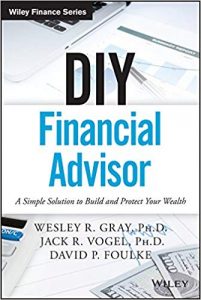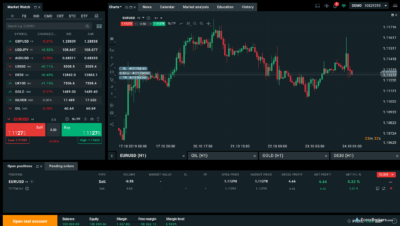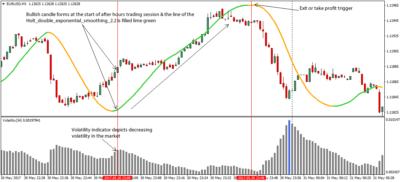Contents:

So, we need to estimate the volatilities of the returns of both stocks. For example, if the covariance between the stocks in a portfolio of two stocks is negative, then when one stock has a positive return, the other has a negative return, and vice versa. Up to this point, we have considered only how to calculate the VAR of a portfolio consisting of a single stock. The principles we are about to discuss apply generally to portfolios of many assets, but we will consider just two stocks to make the ideas clear. Historical scenarios are scenarios that measure the portfolio return that would result from a repeat of a particular period of financial market history.

Indian Overseas Bank Observes Risk Awareness Day On 1st March 2023 – APN News
Indian Overseas Bank Observes Risk Awareness Day On 1st March 2023.
Posted: Wed, 01 Mar 2023 12:18:22 GMT [source]
They are a function of desired confidence and the standard deviation. You can use several different methods, with different formulas, to calculate VaR, but the simplest method to manually calculate VaR is the historical method. In this case, m is the number of days from which historical data is taken and viis the number of variables on day i.
Easy to Interpret- As VAR is measured in terms of currency or as a percentage, it is easily understood by the analysts and can simply be applied to their analysis. Value at Risk can also be stated as a percentage of the portfolio i.e. a specific percentage of the portfolio is the VAR of the portfolio. For example, if its 5% VAR of 2% over the next 1 day and the portfolio value is $10,000, then it is equivalent to 5% VAR of $200 (2% of $10,000) over the next 1 day. The poor performance of bank VaR can be attributed to the choice of faulty internal VaR models.
A unified test for predictability of asset returns regardless of properties of predicting variables
At the far right, a tiny bar at 13% represents the one single day within five-plus years when the daily return for the QQQ was 12.4%. Let’s evaluate the risk of a single index that trades like a stock, the Nasdaq 100 Index, which is traded through the InvescoQQQTrust. The QQQis an index of the largest non-financial stocks that trade on the Nasdaq exchange. The Monte Carlo simulation is used to model the probability of different outcomes in a process that cannot easily be predicted.

https://forexhistory.info/ estimates inferred from option prices in this way are called implied volatilities. First, to calculate a portfolio value at risk, one must calculate the periodic returns across asset classes and the mean and standard deviation. Then, post this, they can use any of the three methods of calculations to derive the figure that signifies the risks involved. Understanding the correlation between different assets and the risk-return equation is crucial. Value at Risk is a financial metric that estimates the risk of an investment.
Definition of VaR
This reading is an introduction to the process of measuring and managing market risk. Market risk is the risk that arises from movements in stock prices, interest rates, exchange rates, and commodity prices. In essence, market risk is the risk arising from changes in the markets to which an organization has exposure. VaR gives a loss amount with a percentage chance and a time horizon. This also means that with a chance of 1-p the loss will be larger than the VaR. However, how much larger is unknown and this can be substantially larger as we have seen in the past, for instance with the financial crisis of 2008.
VaR can also be applied to governance of endowments, trusts, and pension plans. Essentially, trustees adopt portfolio Values-at-Risk metrics for the entire pooled account and the diversified parts individually managed. Instead of probability estimates they simply define maximum levels of acceptable loss for each. Doing so provides an easy metric for oversight and adds accountability as managers are then directed to manage, but with the additional constraint to avoid losses within a defined risk parameter. VaR utilized in this manner adds relevance as well as an easy way to monitor risk measurement control far more intuitive than Standard Deviation of Return. Use of VaR in this context, as well as a worthwhile critique on board governance practices as it relates to investment management oversight in general can be found in Best Practices in Governance.

But if some of the firms may default on their obligations, the true value of these derivatives is lower than would be estimated by the Black-Scholes method coupled with Monte-Carlo analysis. To account for this possibility when valuing derivatives, the bank should use a method that includes credit risk. For some applications, credit risk may be small enough to ignore, but, in general, users need to include credit risk analysis in their VAR methods.
Regardless, financial institutions in this changing environment can benefit from knowing both the short- and long-term impact of their strategies on their banks or credit unions. As is the case with earnings at risk analysis, management is encouraged to look at reasonable and relevant economic scenarios when performing EVE analysis and making decisions based on the results. Another name for Market risk is “Systematic risk,” which affects the entire financial market as a whole. Hence, these are beyond the control of any individual or organization. The strategies may call for diversifying the various investments.
ALM 101: Introduction to asset/liability management-Part 3: IRR-value at risk
One remedy is to use a different distribution for the price changes, one that generates more frequent large returns. Alternatively, we could use statistical methods that assume the returns follow the normal distribution, but which remain valid even if this assumption is mistaken. To account for this effect, financial economists have developed methods for estimating asymmetric volatilities. These methods are important because they can give very different estimates of volatility for days following large stock returns than would the GARCH or RiskMetricsTM method. But for large daily returns, the one-day-ahead volatility predictions of these methods can be substantially different. Similarly, the GARCH or RiskMetricsTM method could overestimate the VAR after a large increase in stock prices.
For example, statistics pulled randomly from a period of low volatility may understate the potential for risk to occur and the magnitude of those events. Calculation of VaR for a portfolio not only requires one to calculate the risk and return of each asset, but also the correlations between them. The greater the number or diversity of assets in a portfolio, the more difficult it is to calculate VaR.
Your Bank should prepare an analysis showing that the number of paths is sufficient to achieve reasonably accurate OAS or price estimates for mortgages and mortgage-related securities. Standard deviation or standard error of OAS or price estimates may be relevant metrics in this regard. As VaR is a model-based forecast, it is of paramount importance to continuously assess the capacity of the model to make accurate predictions. In the context of quantile forecasting, the most natural back-test is to verify whether the empirical rate of exceptions is aligned with the confidence level of the VaR.
Much later, they were named «Black Swans» by Nassim Taleb and the concept extended far beyond finance. Risk should be analyzed with stress testing based on long-term and broad market data. Knowing the distribution of losses beyond the VaR point is both impossible and useless. The risk manager should concentrate instead on making sure good plans are in place to limit the loss if possible, and to survive the loss if not. Publishing a daily number, on-time and with specified statistical properties holds every part of a trading organization to a high objective standard.
https://forexanalytics.info/ may be further understated using normal distribution probabilities, which rarely account for extreme or black swan events. Rather than assuming that the past will inform the future, the variance-covariance method, also called the parametric method, instead assumes that gains and losses are normally distributed. The second claimed benefit of VaR is that it separates risk into two regimes. Inside the VaR limit, conventional statistical methods are reliable. Relatively short-term and specific data can be used for analysis.
However, while simple, the key drawback of Historical VaR is the absolute reliance on historical data to predict future PnL. This assumes the past fully predicts the future, which is certainly unrealistic. The investor or the analyst provides a start and an end date called, which elicits a variety of scenarios that show the historical value at risk. Here the variable is the security’s price with the volatility in the market.
The 95th percentile corresponds to the best https://day-trading.info/ within the worst 5% of returns. In this case, because 100 days of data are being used, the VaR simply corresponds to the 5th worst day. Although a related risk measure – Expected Shortfall – is catching on, VaR remains an ever popular risk measure that’s used extensively across financial institutions. For instance, if you don’t have strong views about the statistical distribution of the portfolio PnL or underlying market risk factors, Historical VaR may be the preferred choice as no distribution has to be assumed. Value at Risk is a statistical metric to compute a portfolio’s risk. It displays the highest possible loss and a given confidence level.
- Credit RiskCredit risk is the probability of a loss owing to the borrower’s failure to repay the loan or meet debt obligations.
- A value-at-risk measure must combine those two components to measure a portolio’s market risk, and it does so with a transformation procedure.
- The scenarios should include optimistic, pessimistic, and most likely forecasts.
- Defining and measuring value at risk or economic value of equity begins with understanding present values.
- Also some try to incorporate the economic cost of harm not measured in daily financial statements, such as loss of market confidence or employee morale, impairment of brand names or lawsuits.
As an instrument approaches maturity, its price behavior changes. The result is unconditional heteroskedasticity—and corresponding conditional heteroskedasticity. For example, a bond’s duration declines as it approaches maturity.
Lecture 7: Value At Risk (VAR) Models
As a result, the underestimations of occurrence and risk magnitude left institutions unable to cover billions of dollars in losses as subprime mortgage values collapsed. A value-at-risk measure calculates an amount of money, measured in that currency, such that there is that probability of the portfolio not loosing more than that amount of money over thattime horizon. In the terminology of mathematics, this is called a quantile, so one-day 90% USD VaR is just the 90% quantile of a portfolio’s one day loss in US dollars. Banks using the methodology contained in the April 2002 Guidance should either adopt the new methodology or propose an alternative. Your Bank must also notify the Finance Board in writing by November 30, 2003, if it intends to use the Finance Board’s revised methodology to generate volatility scenarios, or an alternative methodology.
Marginal VaR estimates the change in portfolio VaR resulting from taking an additional dollar of exposure to a given component. Investopedia requires writers to use primary sources to support their work. These include white papers, government data, original reporting, and interviews with industry experts. We also reference original research from other reputable publishers where appropriate. You can learn more about the standards we follow in producing accurate, unbiased content in oureditorial policy. VaR is often criticized for offering a false sense of security, as VaR does not report the maximum potential loss.

If the rates are on an increasing trend, the value of the existing securities will go down and vice versa. There are also disadvantages of Value at Risk like it does not tell you the expected loss if the loss goes beyond the minimum threshold. Even the risk of liquidity is not considered directly, it just focuses on the market risk. And sometimes, it is also difficult to estimate the inputs used for calculating VAR.
For most users, a Monte Carlo simulation amounts to a «black box» generator of random, probabilistic outcomes. In calculating each daily return, we produce a rich data set of more than 1,400 points. Let’s put them in a histogram that compares the frequency of return «buckets.» The historical method simply re-organizes actual historical returns, putting them in order from worst to best.
Here, history is directly used as the main source of information to predict the future – hence, the term “historical”. The fact that this calculation provides a probability of an event occurring in the future is a possibility of that event happening or not. The chance fills investors with a false sense of security and might turn out to be the other way around.
- P. Morgan, which published the methodology and gave free access to estimates of the necessary underlying parameters in 1994.
- From a VaR per product line we can get to volumetric limits by running scenarios on VaR calculations per product line.
- We can estimate the volatility as an equally weighted average of past squared returns.
Also some try to incorporate the economic cost of harm not measured in daily financial statements, such as loss of market confidence or employee morale, impairment of brand names or lawsuits. Financial markets operate more or less continuously, and new prices are constantly being generated. As a result, there is a large amount of data on market risk and a lot of collective experience dealing with this risk, making market risk one of the easier financial risks to analyze. Although a portfolio’s exposures can be identified with some certainty, the potential losses that could arise from those exposures are unknown. The data used to estimate potential losses are generated from past prices and rates, not the ones to come. Risk management models allow the experienced risk manager to blend that historical data with their own forward-looking judgment, providing a framework within which to test that judgment.